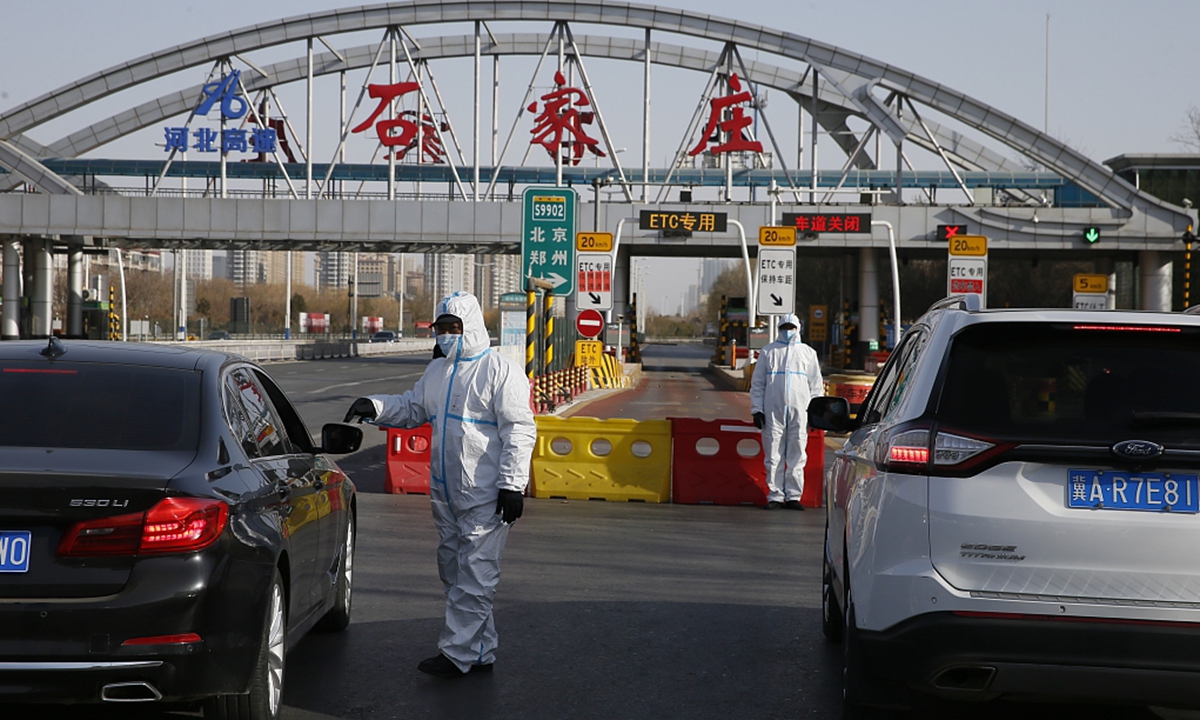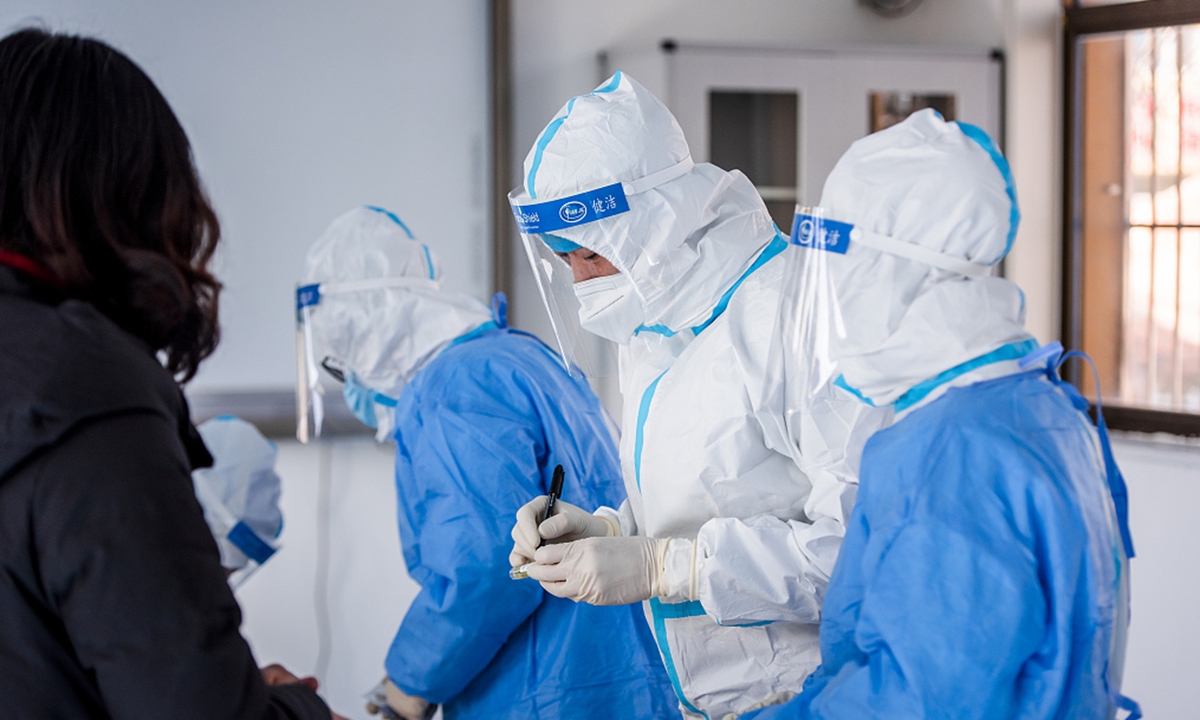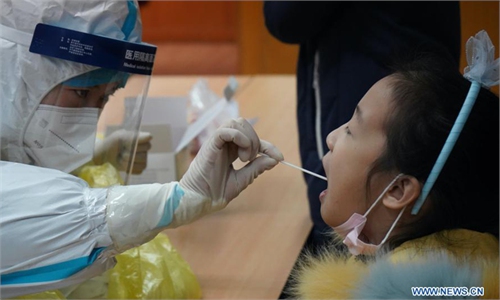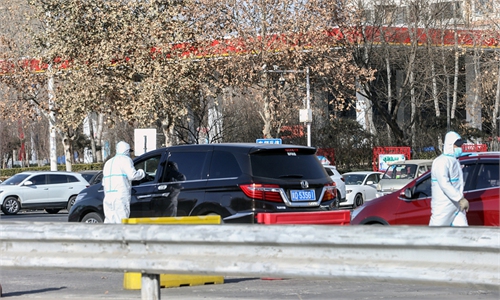Asymptomatic infections likely trigger fresh outbreaks in China, new challenge to virus control work

Shijiazhuang File Photo: VCG
The Chinese mainland is facing a rising virus outbreak in multiple cities ahead of its biggest annual festival following the lockdown of a county in Northeast China's Heilongjiang Province on Monday, after the de facto lockdown in Shijiazhuang, capital city of North China's Hebei Province and the number of daily new cases reaching triple-digits in one day for the first time in five months.Chinese health experts warned that the coronavirus spreading in China appears to be more infectious and transmissible, and asymptomatic infections, especially silent infections in villages, has become a new and big challenge for China, judging from the ongoing Shijiazhuang outbreak and previous outbreak in Northwest China's Xinjiang Uygur Autonomous Region.
A weak and slow COVID-19 response at the grassroots level, which includes a failed surveillance and reporting system in villages, has spawned the recent domestic cluster infections, experts said.
Wangkui county in Northeast China's Heilongjiang Province has entered lockdown with restrictions on transportation and residential communities, after reporting 20 COVID-19 asymptomatic patients on Monday.
The Chinese mainland reported 103 confirmed cases on Monday, mostly from Hebei, the first time for a daily triple-digit rise in the number of confirmed cases in more than five months.
The last time the Chinese mainland reported such a rise was at the end of July, when Urumqi, Xinjiang was hit by daily new cases of over 100.
Zhang Yuexin, a member of anti-epidemic group in Xinjiang, told the Global Times on Monday that Shijiazhuang's fresh outbreak was similar to Xinjiang's, and in both situations the virus spread silently for some time before being detected, which shows that asymptomatic patients have increasingly become a great challenge for China's epidemic prevention and control efforts.
The spread of asymptomatic infections during the epidemic is very limited, but asymptomatic infections may trigger an epidemic, because it depends on how early we find those silent virus carriers, Wu Zunyou, the chief epidemiologist of the Chinese Center for Disease Control and Prevention, said in a transcript obtained by the Global Times.
"The novel coronavirus has a tendency to become influenza in China with its infectivity seemingly stronger than before, although the mortality rate is lower," Zhang said.
Super spreaders have emerged in the Shijiazhuang outbreak, Jin Dongyan, a biomedical professor at the University of Hong Kong, told the Global Times on Monday, noting that super spreaders are likely to cause the second or third wave of virus spreads in the city if the city does not timely identify them and manage them.
The epidemic will affect regions during the Spring Festival holiday, which falls in February, and will see tightened restrictions on the movement of local people in these regions. But experts believe that the recent multiple outbreaks in China are controllable and will not lead to a second national outbreak, as China has formed a complete and effective response mechanism.
To guard the capital against the recent outbreaks in Hebei, the Beijing municipal government has adopted what some people believe to be the strictest traffic control measures on Monday, requiring checks on every vehicle and person that passes through the nine checkpoints into Beijing.
The number of daily new cases is also a result of the expanded nucleic acid testing in the city, and Shijiazhuang is likely to control the epidemic in two to four weeks, Jin said.
Shijiazhuang has finished its first round of citywide testing, and is undergoing its second round.

Shijiazhuang File Photo: VCG
Loopholes
The timely detection of the silent infections is a major problem facing China, and regular nucleic acid testing for key groups such as people working in cold chain imports sectors or customs has been implemented. But regular testing for ordinary people was unrealistic, experts said.
Jin said the government needs to appeal to residents that they cannot ignore minor discomfort and need to visit their doctor timely.
Zhang said it's necessary to train medics in villages on how to perform nucleic acid testing, and to include the village's medical warning and surveillance to the national mechanism so that suspicious cases could be monitored and reported.
The epidemic in Shijiazhuang and Wangkui county mostly occurred in rural areas where patients in both regions attended gatherings such as weddings, Jin said.
Rural residents are accustomed to visit clinics for medical treatment which is impossible to detect and treat cases in time due to low medical levels, Wang Guangfa, a respiratory expert at Peking University First Hospital, told the Global Times.
Some experts also pointed out that the vacancy of the post of mayor in Shijiazhuang could also be a factor resulting in slow response of the city government in epidemic control and prevention, which has seen the city's first press conference since the new outbreak delayed for two hours.
The post of mayor of Shijiazhuang had been vacant for at least half a month before Ma Yujun was appointed vice mayor and acting mayor on January 8. The former mayor, Deng Peiran, was under investigation for suspected severe violations of discipline and the law since December 21, 2020.
Wang Hongwei, a professor at Renmin University of China's School of Public Administration and Policy, told the Global Times on Monday that the absence of a mayor in Shijiazhuang was likely to affect local epidemic control and prevention, but his role was not decisive, as the party secretary of the city, also the leader of the local leading group of epidemic prevention and control, could still run the group.
Wang said that on the administrative level, one of the lessons Shijiazhuang and other parts of the country should draw is that grassroots level governments, especially village-level governments, failed to play its role of monitor and surveillance in epidemic control.
Imported virus strain
The recent domestic outbreaks in several cities have pointed to imported sources, mostly European strain.
The outbreak in Northeast China's coastal city of Dalian was likely caused by coronavirus contaminated imported frozen products, the local government said on Monday. The coronavirus strain spreading in Hebei Province has also been determined to be an imported one, very likely from Europe.
Many of the cases in places where the virus strain were imported involved asymptomatic infections or cases with an incubation period longer than 14 days.
Zhang said that there was no clear evidence that the imported virus strain, specifically the European virus strain, is more likely to cause asymptomatic infections or infections with longer incubation periods.
"But we know that the imported virus strain is far more infectious and pathogenic than the virus spreading in Wuhan," Yang Zhanqiu, deputy director of the pathogen biology department at Wuhan University, told the Global Times.
As for asymptomatic infections, Yang said that he believes the majority of the cases during the Wuhan outbreak were asymptomatic infections, too, meaning asymptomatic infections were not a new issue but a increasingly pressing challenge.
Experts said more studies on the sites of the sequence of the imported virus stain need to be conducted to understand the characteristics of the imported virus strain and its influence on the domestic outbreak.
Chen Qingqing contributed to this story






